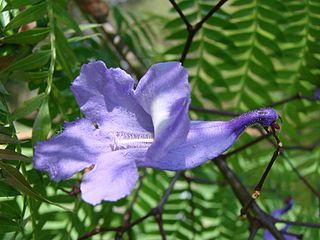
Tabebuia is a genus of flowering plants in the family Bignoniaceae. The common name "roble" is sometimes found in English. Tabebuias have been called "trumpet trees", but this name is usually applied to other trees and has become a source of confusion and misidentification.

Bignoniaceae is a family of flowering plants in the order Lamiales commonly known as the bignonias. It is not known to which of the other families in the order it is most closely related.

Jacaranda is a genus of 49 species of flowering plants in the family Bignoniaceae, native to tropical and subtropical regions of the Americas.

Bignonia is a genus of flowering plants in the family Bignoniaceae. Its genus and family were named after Jean-Paul Bignon by his protégé Joseph Pitton de Tournefort in 1694, and the genus was established as part of modern botanical nomenclature in 1753 by Carl Linnaeus. Species have been recorded from the southern USA, Central to most of South America.

Fridericia chica, the cricket-vine, puca panga, chica, carayurú (Spanish), carajuru or crajiru (Portuguese), is a medicinal plant in the family Bignoniaceae, also used for cosmetics. An orange-red dye called chica, crajiru or carayurú is obtained from boiling the leaves. It is used by some native South American peoples to stain the skin.

Amphitecna is a genus of plants in the family Bignoniaceae.

Alwyn Howard Gentry was an American botanist and plant collector, who made major contributions to the understanding of the vegetation of tropical forests.

Zinnia elegans known as youth-and-age, common zinnia or elegant zinnia, is an annual flowering plant in the daisy family Asteraceae. It is native to Mexico but grown as an ornamental in many places and naturalised in several places, including scattered locations in South and Central America, the West Indies, the United States, Australia, and Italy.

Mansoa is a genus of tropical, flowering vines in the family Bignoniaceae.

Handroanthus is a genus of flowering plants in the family Bignoniaceae. It consists of 30 species of trees, known in Latin America by the common names poui, pau d'arco, or ipê. The latter sometimes appears as epay or simply ipe (unaccented) in English. The large timber species are sometimes called lapacho or guayacan, but these names are more properly applied to the species Handroanthus lapacho and Handroanthus guayacan, respectively.

Roseodendron is a genus of flowering plants in the family Bignoniaceae. It consists of two species, Roseodendron donnell-smithii and Roseodendron chryseum. The type species for the genus is R. donnell-smithii. Both species are cultivated as ornamentals for their numerous, large, yellow flowers.
Ekmanianthe is a genus of flowering plants in the family Bignoniaceae. It is most closely related to Tabebuia and has sometimes been included within it. It consists of two species of trees, neither of which is especially common in any part of its range. Ekmanianthe longiflora grows to 18 m (59 ft) in height and is native to Haiti and the rocky uplands of central Cuba. Ekmanianthe actinophylla is a smaller tree, to 10 m (33 ft) in height, and it occurs in western Cuba where it is known as "roble caimán", for the resemblance of its trunk bark to the hide of a caiman. "Roble" is a Spanish name that is also applied to Tabebuia. Neither of the species of Ekmanianthe is known in cultivation. The type species for Ekmanianthe is E. longiflora. The wood of Ekmanianthe has been variously described as "soft" or as "very hard, heavy, and strong". Despite this, like many other Tecomeae species, it is rarely cultivated.

Astianthus is a monotypic genus of flowering plants in the Bignoniaceae family. The sole species is Astianthus viminalis. It is known by the common names achuchil in Mexico and chilca in Guatemala and Honduras.

Exarata is a group of plants described as a genus in 1992.

Amphilophium is a genus of flowering plants in the family Bignoniaceae, native to South America. Amphilophium crucigerum has escaped from cultivation elsewhere.

Tanaecium is a genus of flowering plants in the family Bignoniaceae, native to south and Central America.

Dolichandra is a genus of flowering plants in the family Bignoniaceae, native to Latin America and the Caribbean. They are climbing lianas with trifid and uncate tendrils.
Xylophragma is a genus of flowering plants in the family Bignoniaceae, native to dry forests of Mexico, Central America, Trinidad and northern South America. They are lianas or scandent shrubs.

Heterophragma is a genus of two species of tree, constituting part of the plant family Bignoniaceae. The species are found in Southeast Asia and India.















